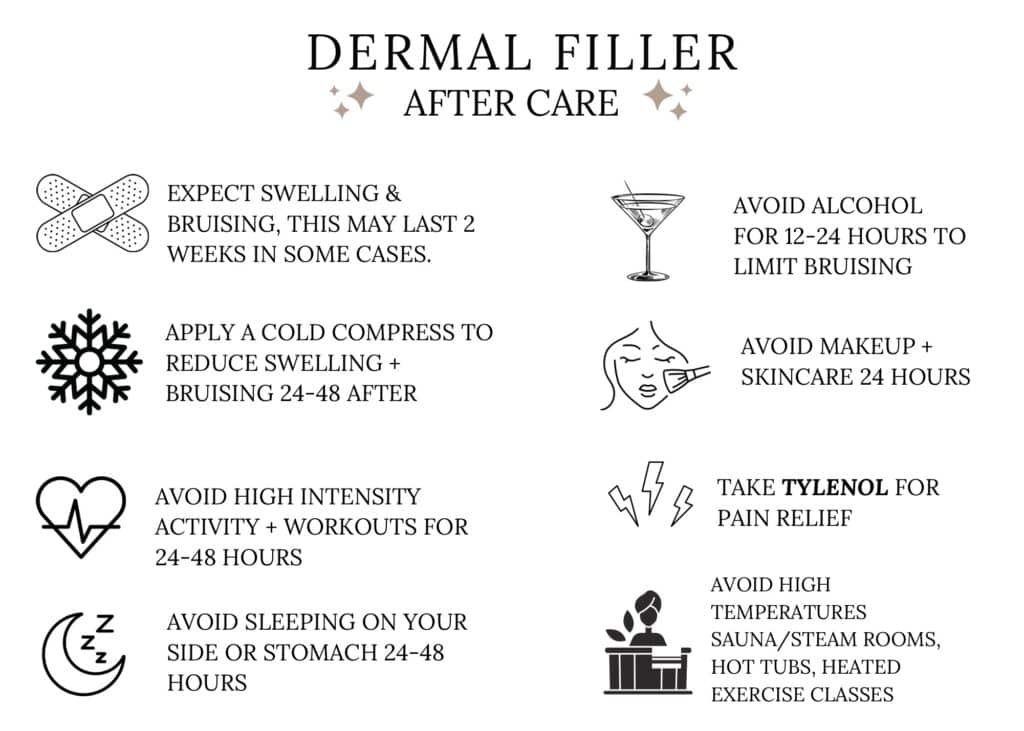Did you know that over 2.6 million dermal filler procedures were performed in the U.S. last year? With popularity soaring, knowing how to care for your skin post-injection is crucial. Recovery tips after radiesse fillers and derma filler injections can make all the difference in achieving the best results, especially for those experiencing facial volume loss.
Swelling and bruising are common, but they don’t have to last long. Simple steps can speed up healing and keep your skin looking fresh. From avoiding certain activities to using cold compresses, these tips are easy to follow. Get ready for your dermal filler appointment to flaunt your fabulous new look with confidence after the filler treatment session and following the detailed filler instructions. Your skin deserves the best care possible after those fillers!
Key Takeaways
- Follow immediate post-injection care by avoiding touching the treated area to ensure optimal healing.
- Manage common side effects like swelling and bruising with cold compresses, which can help reduce discomfort.
- Stay hydrated after your dermal filler injections, as it supports skin elasticity and overall recovery.
- Use over-the-counter pain relief methods as needed, but consult your doctor if pain persists.
- Prioritize sleep and rest to allow your body to heal effectively after the procedure.
- Avoid strenuous activities for at least 24 hours post-injection to minimize the risk of complications.
Understand Dermal Fillers
Types of Fillers
Dermal fillers come in various types. Juvederm and Radiesse are popular options. Juvederm is a hyaluronic acid-based filler. It adds volume to areas like cheeks and lips. Radiesse, on the other hand, uses calcium hydroxylapatite. It helps with deeper wrinkles and facial contouring.
Each filler has its specific use. Some fillers work better for fine lines, while others target volume loss. Understanding these differences can help during your dermal filler appointment.
Effects of Fillers
Fillers provide significant improvement in appearance. They can enhance facial features and restore lost volume. However, they do not completely remove all wrinkles. Results vary from person to person.
e individuals may still see faint lines after treatment. It’s essential to have realistic expectations about the outcome of dermal filler injections.
Treatment Sessions
Multiple dermal filler treatments may be necessary for optimal results. Some people require touch-ups after initial sessions. This ensures that the desired look is maintained over time after each filler treatment session, following the filler instructions provided during the dermal filler appointment.
Filler treatment sessions typically last around 30 minutes to an hour. The effects can last from six months to two years after a filler treatment session, depending on the product used during the dermal filler appointment and following the filler instructions.
Side Effects
Understanding dermal filler side effects is crucial before treatment. Common side effects after a filler treatment session include swelling, bruising, and redness at the injection site, as noted in the filler instructions. These usually resolve within a few days.
Serious side effects are rare but can occur. These include infections or allergic reactions. Always discuss potential risks with your provider before proceeding with filler treatments.
Aftercare Instructions
Following detailed filler instructions is important for recovery. Avoid strenuous exercise for 24 hours post-treatment. This helps minimize swelling and bruising.
You should also refrain from touching your face immediately after the procedure, following the filler instructions. Keeping the area clean will reduce the risk of infection.
Staying hydrated can aid recovery. Drinking plenty of water supports skin health and enhances results from dermal fillers.
Realistic Expectations
Realistic expectations play a key role in satisfaction with dermal filler products. Understand that everyone’s skin reacts differently to treatments. Some may achieve their ideal look quickly with filler instructions while others need more time.
Discuss your goals and filler instructions with your healthcare provider during your consultation. They can guide you on what to expect from each dermal filler option.
Immediate Post-Injection Care
Right Aftercare Routine
Following your injectable treatments, it’s crucial to follow the aftercare instructions provided by your healthcare provider. This guidance helps ensure optimal results from your treatment. The right aftercare routine and filler instructions can reduce risks and enhance the effects of the injections.
Avoid touching or massaging the treated area immediately after the injection. This action can lead to complications like uneven results or increased swelling. It’s also essential to remain cautious about the products you apply to your skin.
Temporary Swelling
Temporary swelling is common after fat injections and other dermal fillers. This swelling usually appears within a few hours post-treatment and may last for several days. Ice packs can help manage this swelling, but only if recommended by your healthcare provider.
Keep in mind that some areas may swell more than others. This variation depends on individual anatomy and the type of filler used. If swelling persists beyond a week, contact your provider for advice.
Days Post Treatment
During the first few days post-treatment, refrain from applying makeup or skincare products for at least 24 hours. Makeup can irritate the injection sites and increase the risk of infection. Allowing your skin to breathe during this time supports healing.
After 24 hours, you may resume light makeup application if there are no signs of irritation. Always check with your healthcare provider before resuming any skincare routine.
Topical Treatment
Topical treatments should be avoided during the initial recovery phase. These products can interfere with the healing process and affect the final results of your injections. Your skin needs time to adjust and recover from the invasive procedures.
If you have specific concerns about skincare products, discuss them with your provider beforehand. They can recommend safe options that won’t disrupt your recovery.
Future Treatment Plans
Consider how these initial care steps influence future treatment plans. Proper aftercare can lead to better outcomes in subsequent sessions. By demonstrating responsible care after each treatment, you build a foundation for effective long-term results.
Document how your skin reacts to each injection. Share this information with your provider during follow-up appointments. This dialogue ensures tailored approaches that align with your skin’s needs.
Manage Common Side Effects
Bruising
Bruising is a common side effect after dermal filler injections. It occurs when small blood vessels break under the skin. This results in discoloration and swelling. Bruises usually appear within a day or two after the procedure. They can last for several days but typically fade away on their own.
Applying ice packs can help reduce bruising. Wrap ice in a cloth and place it on the bruised area for about 10-15 minutes. This should be done multiple times a day during the first 48 hours.
Swelling
Swelling often follows dermal filler injections. This happens as the body reacts to the filler material. Swelling can last anywhere from a few hours to several days. Most of the time, it will start to decrease within 24-48 hours.
Elevating your head while sleeping can minimize swelling. Staying hydrated also helps. Drinking plenty of water allows your body to recover faster. If swelling persists, consult your healthcare provider.
Redness
Redness around the injection site is normal. It usually appears immediately after the procedure and may last for a few hours to a couple of days. This redness is often temporary and should not cause concern.
Using over-the-counter antihistamines like Benadryl can provide relief from minor redness and itching. Always follow the recommended dosage on the label or consult with your doctor if unsure.
Lumps or Bumps
Lumps or bumps may form after injections due to uneven distribution of the filler. These are usually harmless but can be bothersome. Gently massaging these areas with constant pressure can help them dissolve over time.
Use your fingers to apply light pressure on any lumps you feel. Do this for a few minutes each day until they smooth out. Avoid pressing too hard, as this could cause further irritation.
Pain Management
Mild pain may occur post-injection. Over-the-counter pain relievers like ibuprofen can help manage discomfort. Always consult your doctor before taking any medication, especially if you have existing health issues.
Resting and avoiding strenuous activities for at least 24 hours post-procedure is crucial. This allows your body to heal properly without additional stress.
Monitoring Side Effects
It’s essential to monitor side effects closely after receiving dermal fillers. If any side effects worsen or do not improve within a week, seek medical advice immediately. Not all reactions are typical, and professional assessment is vital for your safety.
Importance of Hydration
Water Intake
Increasing water intake is crucial after receiving dermal filler injections. Hyaluronic acid is a key ingredient in many fillers. It attracts and retains moisture in the skin. Staying hydrated helps maintain skin elasticity and supports healing.
Drinking enough water can also help reduce swelling. Swelling is a common side effect after the procedure. Proper hydration can speed up recovery time. Aim for at least eight glasses of water daily. This simple step can make a significant difference in how your skin looks and feels.
Avoid Alcohol and Caffeine
Avoiding alcohol and caffeine is equally important. Both substances can lead to dehydration. Dehydrated skin may appear dull and lifeless. Alcohol can also increase inflammation, worsening any swelling you might experience after the injections.
Caffeine has similar effects. It can constrict blood vessels, reducing circulation to the skin. This reduction can slow down the healing process. Staying away from these drinks will support your body’s recovery efforts.
Use Hydrating Products
Consider using a hydrating serum or moisturizer as part of your skincare routine. Products that contain hyaluronic acid can be particularly beneficial. They help to lock in moisture and keep the skin supple.
Apply a hydrating serum twice daily for best results. Look for ingredients like glycerin or aloe vera, which are known for their moisturizing properties. These products help create a barrier on the skin, preventing moisture loss.
Using a gentle moisturizer can also soothe the skin post-injection. Choose non-comedogenic options to avoid clogging pores. Keeping your skin well-hydrated will not only enhance its appearance but also improve comfort during recovery.
Monitor Skin Condition
Monitoring your skin condition is vital during recovery. Pay attention to any changes or reactions after the filler injections. If you notice increased dryness or irritation, adjust your hydration strategies accordingly.
Incorporate foods with high water content into your diet as well. Fruits like watermelon, cucumbers, and oranges provide hydration from within. These foods are rich in vitamins that promote healthy skin.
Hydration plays a key role in achieving optimal results after filler treatments. Following these tips will ensure your skin remains healthy, plump, and radiant as it heals.
Use Cold Compresses
Bruising Relief
Cold compresses can help reduce bruising after dermal filler injections. Applying cold to the area constricts blood vessels. This action limits blood flow, which helps minimize bruising.
Using a cold compress immediately after the procedure is most effective. Start this process as soon as possible. It’s best to apply it for 20 minutes on and then take a break for 20 minutes. Repeat this several times throughout the day. This schedule provides consistent relief and helps the healing process.
Swelling Control
Facial swelling is common after filler injections. Cold compresses can significantly alleviate this discomfort. The cool temperature soothes the skin and reduces inflammation.
Ensure that the compress is not too cold. Excessive cold can lead to skin damage or frostbite. Wrap ice packs or frozen vegetables in a thin cloth before applying them to your face. This method keeps the skin safe while still providing relief.
Application Tips
Using cold compresses effectively requires some simple steps. First, prepare your compress by wrapping ice cubes in a cloth or using a gel pack. Then, find a comfortable spot to relax while you apply it.
Here are some tips for application:
- Clean the Area: Before applying, wash your face gently.
- Position Comfortably: Lay back and place the compress over the treated areas.
- Monitor Time: Keep track of the 20-minute intervals closely.
- Take Breaks: Allow your skin to rest between applications.
- Stay Hydrated: Continue drinking water to aid recovery.
These steps will enhance comfort and support faster healing.
Emotional Impact
Experiencing swelling or bruising can be stressful. Many people worry about how they will look post-treatment. Cold compresses provide not only physical relief but also emotional comfort. Knowing that you are taking steps to care for yourself can ease anxiety.
By managing these symptoms, individuals can feel more at ease during their recovery period. They can focus on enjoying their results instead of worrying about temporary side effects.
Pain Relief Methods
Over-the-Counter Medications
Pain relief is essential after derma filler injections. Taking over-the-counter medications can help manage discomfort. Tylenol or Motrin are popular choices. They can alleviate headaches or pain at the injection site. These medications work well for mild to moderate pain.
Avoid using aspirin or blood thinners. These substances can increase bruising and bleeding, which may complicate healing. If you experience significant discomfort, consider reaching out to your healthcare provider.
Ice Packs and Cold Compresses
Cold compresses are effective in reducing swelling and pain. Applying ice packs to the injection area can provide immediate relief. Use a clean cloth to wrap the ice pack. Apply it for 10 to 15 minutes at a time. Repeat this every few hours during the first 24 hours after treatment.
This method complements previous treatments like cold compresses. It helps minimize inflammation and speeds up the healing process.
Monitoring Symptoms
Monitoring your symptoms is crucial after lip enhancement treatment. Pay attention to any unusual changes at the injection site. Mild swelling and redness are common right after the procedure. These should gradually decrease within a few days.
If pain persists beyond three days, consult with your doctor. Persistent pain may indicate an underlying issue that needs addressing. Your healthcare provider can evaluate your condition and recommend further treatment if necessary.
Hydration and Rest
Stay hydrated during your recovery period. Drinking plenty of water supports overall health and aids in the healing process. Proper hydration helps maintain skin elasticity and reduces dryness.
Rest is equally important after receiving fillers. Avoid strenuous activities for at least 24 hours post-treatment. This includes heavy lifting, exercise, and other high-impact activities. Allowing your body to rest promotes faster recovery.
Follow-Up Care
Follow-up care is key to ensuring optimal results from your treatment. Schedule a follow-up appointment with your provider within a week of your filler injections. This visit allows your doctor to assess the treatment’s effectiveness and address any concerns you might have.
During this appointment, discuss any side effects or unusual symptoms you’ve experienced. Open communication with your healthcare provider fosters trust and ensures a smoother recovery process.
Sleep and Rest Advice
Head Elevation
Sleep with your head elevated. This position helps minimize swelling after dermal filler injections. Keeping the head raised promotes better circulation. Use an extra pillow or a wedge pillow for support.
Swelling is common in the first few days. Elevating your head can reduce this effect. It also aids in faster recovery. Many people notice less puffiness by following this advice.
Avoid Pressure
Avoid sleeping on your face. This action can put pressure on treated areas. Pressure may lead to uneven results or increased bruising. Choose to sleep on your back instead.
Using a special pillow can help maintain this position. Look for pillows designed for side sleepers, which allow you to rest comfortably without pressure on your face.
Adequate Rest
Ensure adequate rest during recovery time. The body needs time to heal after dermal filler injections. Getting enough sleep supports the body’s natural healing process.
Aim for 7 to 9 hours of quality sleep each night. Good sleep habits can enhance recovery. Limit screen time before bed to improve sleep quality.
Fatigue can slow down the healing process. Listen to your body and take naps if needed. Avoid strenuous activities that could disrupt recovery.
Recovery Information
Understand that full recovery time varies per person. Some might see improvements within a few days, while others may take longer. Factors like age, health, and the amount of filler used play a role.
Consult with your provider about what to expect during recovery. They can offer personalized advice based on your situation. Following their instructions will lead to better results.
In summary, proper sleep and rest are crucial after dermal filler injections. Elevating your head reduces swelling and promotes healing. Avoiding pressure on treated areas prevents complications. Lastly, ensuring adequate rest supports overall recovery time.

Avoid Strenuous Activities
Exercise Limitations
Refraining from vigorous exercise is crucial after receiving dermal filler injections. This restriction should last for at least 24-48 hours. Engaging in strenuous activities too soon can increase the risk of significant bruising. Physical exertion raises blood flow, which may lead to more swelling and discomfort.
During this recovery period, it’s best to focus on light activities. Gentle walking or stretching is acceptable. However, high-impact workouts or heavy lifting should wait. Listen to your body and prioritize healing.
Temperature Concerns
Avoiding saunas, hot tubs, and direct sun exposure is also important. High temperatures can worsen irregular swelling. Heat causes blood vessels to expand, leading to increased fluid retention in the treated areas. Staying cool helps reduce swelling and promotes a smoother recovery.
Instead of hot baths or sunbathing, consider cooler showers. A cool compress can provide relief if swelling occurs. Always follow your healthcare provider’s advice regarding temperature exposure.
Gradual Resumption
Gradually resuming normal activities is essential for a successful recovery. Follow your healthcare provider’s guidance on when to return to regular routines. Each person’s recovery timeline differs based on individual factors.
After the initial 24-48 hours, you may slowly reintroduce moderate activities. Start with gentle exercises and monitor how your body responds. If you notice any unusual symptoms, seek medical advice promptly.
Listening to your body during recovery is vital. If you feel discomfort or pain, take a step back and rest. It’s better to err on the side of caution than rush back into your routine.
Skincare and Makeup Tips
Wait Before Makeup
After cosmetic treatments, it’s crucial to give your skin time to recover. Wait at least 24 hours before applying any makeup. This allows the skin to settle and reduces the risk of irritation. Applying makeup too soon can lead to complications, such as increased swelling or infection.
Makeup products can trap bacteria on the skin. This is especially true if the skin is still healing from a cosmetic procedure. For best results, allow your skin to breathe for the first day.
Gentle Products
Use gentle, non-comedogenic skincare products after facial treatments. Non-comedogenic means that these products won’t clog pores. Clogged pores can lead to breakouts and irritation. Look for products labeled as hypoallergenic, as they are less likely to cause reactions.
Avoid harsh ingredients like alcohol or strong fragrances. These can irritate sensitive skin post-treatment. Instead, opt for soothing ingredients like aloe vera or chamomile. They help calm the skin and promote healing.
Mineral Makeup
Opt for mineral-based makeup to cover any residual bruising after your facial treatments. Mineral makeup is lighter and less likely to clog pores compared to traditional options. It provides coverage without suffocating the skin.
Mineral makeup often contains natural ingredients that soothe the skin. Products with zinc oxide can even provide some sun protection. This is important because newly treated skin can be more sensitive to sunlight.
Avoid Active Ingredients
Stay away from active ingredients in skincare for at least a week post-injection. Ingredients like retinol or acids can irritate healing skin. They may cause redness or peeling, which is not ideal after a cosmetic procedure.
Instead, focus on hydration and protection during this period. Use moisturizers that are rich in hyaluronic acid or glycerin. These ingredients help maintain moisture levels without causing irritation.
Hydrate Well
Drinking plenty of water aids recovery after wrinkle removal procedures. Staying hydrated promotes healthy skin and speeds up healing. Aim for at least eight glasses of water daily.
Consider incorporating hydrating foods into your diet as well. Foods like cucumbers, oranges, and berries are great choices. They provide essential vitamins and minerals that support skin health.
Monitor Your Skin
Keep an eye on how your skin reacts post-treatment. If you notice unusual redness, swelling, or pain, contact your provider immediately. Early intervention can prevent complications from becoming serious issues.
Final Remarks
Taking care of yourself after dermal filler injections is crucial for the best results. Follow these recovery tips to ensure your skin heals properly and looks fabulous. From managing side effects to staying hydrated, each step plays a role in your recovery journey. Prioritize rest and avoid strenuous activities to give your body the chance it needs to adjust.
Don’t forget the importance of skincare and makeup tips to help you feel confident while healing. You’re investing in yourself, so treat this process with care. For more insights and personalized advice, reach out to a professional who can guide you. Your skin deserves it!
Frequently Asked Questions
What are dermal fillers?
Dermal fillers are injectable substances used to restore volume, smooth wrinkles, and enhance facial contours. They can improve skin texture and provide a more youthful appearance.
How can I care for my skin immediately after injections?
Immediately after dermal filler injections, avoid touching your face. Apply a cold compress to reduce swelling and follow your provider’s specific post-care instructions for optimal recovery.
What side effects should I expect?
Common side effects include swelling, bruising, and tenderness at the injection site. These usually subside within a few days. If symptoms persist or worsen, consult your healthcare provider.
Why is hydration important after filler injections?
Staying hydrated helps maintain skin elasticity and supports healing. Drinking water can also minimize swelling and promote overall recovery after dermal filler treatments.
Can I apply makeup after dermal fillers?
It’s best to wait at least 24 hours before applying makeup to allow the skin to heal properly. Follow your provider’s advice for when it’s safe to resume your usual skincare routine.
What activities should I avoid post-injection?
Avoid strenuous activities, heavy exercise, and excessive sun exposure for at least 24-48 hours post-injection. This helps prevent complications and ensures optimal results from your treatment.
When can I sleep normally after getting fillers?
Try to sleep on your back for the first few nights following your procedure. This reduces pressure on the treated areas and helps minimize swelling.





